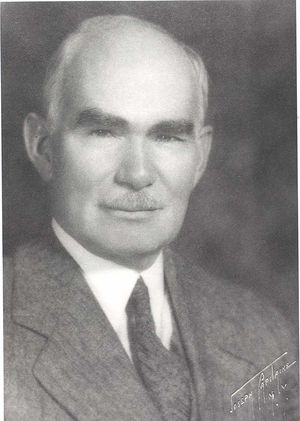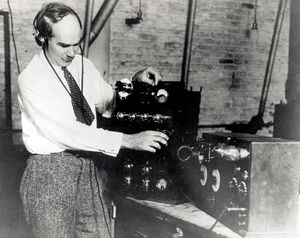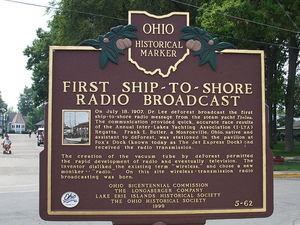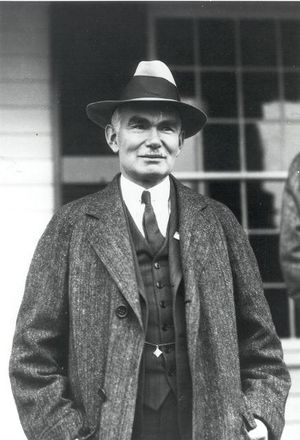Lee De Forest: Difference between revisions
No edit summary |
No edit summary |
||
| (2 intermediate revisions by the same user not shown) | |||
| Line 1: | Line 1: | ||
== Biography == | == Biography == | ||
[[Image:1095 De Forest Protrait, copyright IEEE.jpg|thumb|right|Lee De Forest]] | |||
[[Image: | [[Image:DeForestRadio0050.jpg|thumb|right]] | ||
[[Image:LeeDeforestOhioMarker.jpg|thumb|right|Historical Marker in Ohio Commemorating De Forest's Ship-to-Shore Radio Broadcast]] | |||
[[Image: | [[Image:De Forest Light's Gold Jubilee0161.jpg|thumb|right]] | ||
<p>Born: 26 August 1873 <br>Died: 30 June 1961 <br></p> | |||
Lee De Forest was born in 1873 and grew up in Alabama. He became interested in machinery as a young child but repeatedly clashed wills with his father, who wanted him to study for the ministry. Desperate to convince his father to send him to the Sheffield Scientific School at Yale, he forged his father’s name on a letter to [[Thomas Alva Edison|Thomas Edison]] asking the great inventor what a man should do with a son who wanted to become an engineer. [[Thomas Alva Edison|Edison]] never replied, but De Forest was eventually allowed to follow his scientific inclinations. | Lee De Forest was born in 1873 and grew up in Alabama. He became interested in machinery as a young child but repeatedly clashed wills with his father, who wanted him to study for the ministry. Desperate to convince his father to send him to the Sheffield Scientific School at Yale, he forged his father’s name on a letter to [[Thomas Alva Edison|Thomas Edison]] asking the great inventor what a man should do with a son who wanted to become an engineer. [[Thomas Alva Edison|Edison]] never replied, but De Forest was eventually allowed to follow his scientific inclinations. | ||
| Line 21: | Line 23: | ||
<p>Despite the many controversies surrounding De Forest and his work, he received numerous awards recognizing his contributions, including the 1922 [[IEEE Medal of Honor|Medal of Honor of the Institute of Radio Engineers]] and the 1946 [[IEEE Edison Medal|Edison Medal]] from the [[AIEE History 1884-1963|AIEE]] 'For pioneering achievements in radio and for the invention of the grid-controlled vacuum tube with its profound technical and social consequences.' Notably, Armstrong also received the [[IEEE Edison Medal|Edison Medal]], four years earlier, 'For distinguished contributions to the art of electric communication, notably the regenerative circuit, the superheterodyne and frequency modulation.'</p> | <p>Despite the many controversies surrounding De Forest and his work, he received numerous awards recognizing his contributions, including the 1922 [[IEEE Medal of Honor|Medal of Honor of the Institute of Radio Engineers]] and the 1946 [[IEEE Edison Medal|Edison Medal]] from the [[AIEE History 1884-1963|AIEE]] 'For pioneering achievements in radio and for the invention of the grid-controlled vacuum tube with its profound technical and social consequences.' Notably, Armstrong also received the [[IEEE Edison Medal|Edison Medal]], four years earlier, 'For distinguished contributions to the art of electric communication, notably the regenerative circuit, the superheterodyne and frequency modulation.'</p> | ||
[[Category:People and organizations|Deforest]] [[Category:Power, energy & industry | [[Category:People and organizations|Deforest]] [[Category:Power, energy & industry applications|Deforest]] [[Category:Power generation|Deforest]] [[Category:Generators|Deforest]] [[Category:Communications|Deforest]] [[Category:Telegraphy|Deforest]] [[Category:Wireless telegraphy|Deforest]] [[Category:Radio communication|Deforest]] [[Category:Radio broadcasting|Deforest]] [[Category:News|Deforest]] | ||
Revision as of 16:51, 14 March 2014
Biography
Born: 26 August 1873
Died: 30 June 1961
Lee De Forest was born in 1873 and grew up in Alabama. He became interested in machinery as a young child but repeatedly clashed wills with his father, who wanted him to study for the ministry. Desperate to convince his father to send him to the Sheffield Scientific School at Yale, he forged his father’s name on a letter to Thomas Edison asking the great inventor what a man should do with a son who wanted to become an engineer. Edison never replied, but De Forest was eventually allowed to follow his scientific inclinations.
Before going to Yale in 1893, De Forest traveled to the Chicago World’s Fair. When he ran out of money soon after arriving, he worked as a strikebreaker for the grounds crew, pushing the wheelchairs of disabled or exhausted tourists. He had little sympathy for either the workers on strike or his customers, whom he overcharged in order to make enough money to prolong his stay. De Forest eventually arrived at Yale and remained there until he received a doctorate in physics for his work on radio waves.
De Forest’s first job was at Western Electric in Chicago. He worked his way up to the experimental laboratory and developed a few modestly successful inventions, which spurred him to move to New York and start the De Forest Wireless Telegraph Company in 1902. Though this company did not last long, in 1907 De Forest patented the Audion, a three element vacuum tube that was a sensitive wireless receptor. He began to experiment with broadcasting speech and music and discovered that he could cause regenerative oscillation by feeding the output of the Audion back into its grid. This discovery allowed for more powerful and effective signal transmission.
De Forest was a pioneer broadcaster in addition to an inventor and engineer. He set up a radio station in the Bronx in 1916. However, his reliance on spark transmitters and inability to make radio transmission profitable excluded him from broadcast success. From this period on, De Forest was involved in several failed companies and long patent suits. One of the most famous patent battles was with Edwin H. Armstrong. Armstrong had used the Audion as a basis for his regenerative circuit, which was much more successful. De Forest won the suit, but his peers felt that the real scientific achievement belonged to Armstrong.
During the 1920s De Forest began to work on a system for producing motion pictures with sound. The operating quality of his optical recording system was poor and failed to interest the film industry. However, when the motion picture industry later adopted the concept of sound on film, a process very similar to De Forest’s was used. In general, De Forest’s attempts to establish himself as a businessman were not only unsuccessful but also damaging to his career, as bankruptcy and suspicions of fraud invariably attached themselves to his business enterprises. He was also hurt by a difficult personality that led to three failed marriages, (the second to engineer Nora Stanton Blatch was particulary messy) before a fourth happy marriage to actress Marie Mosquini. By the end of his career, De Forest had earned more than three hundred patents but never achieved the status of “Father of Radio” that he sought for himself.
Despite the many controversies surrounding De Forest and his work, he received numerous awards recognizing his contributions, including the 1922 Medal of Honor of the Institute of Radio Engineers and the 1946 Edison Medal from the AIEE 'For pioneering achievements in radio and for the invention of the grid-controlled vacuum tube with its profound technical and social consequences.' Notably, Armstrong also received the Edison Medal, four years earlier, 'For distinguished contributions to the art of electric communication, notably the regenerative circuit, the superheterodyne and frequency modulation.'



